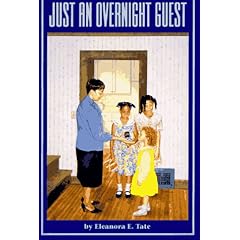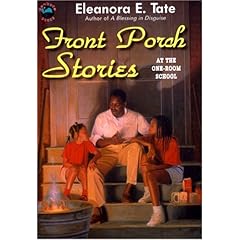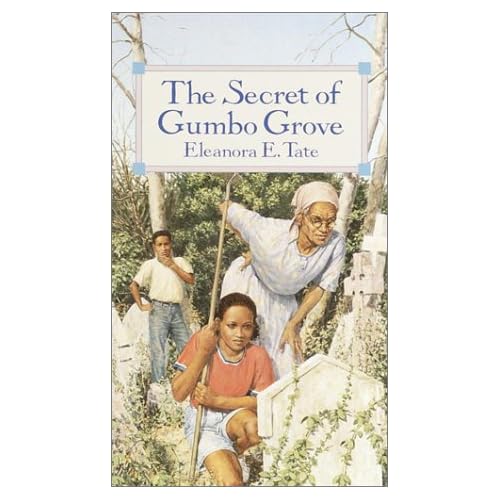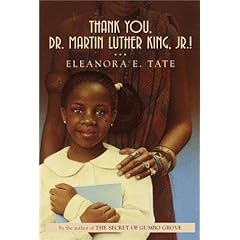
Eleanora E. Tate’s eyes glimmer with the twinkle of a teacher. She passes along wisdom with a heap of humor and grace. That’s a quality of her acclaimed stories too. Author of 11 books, Tate celebrates neighborhoods, families and communities with plots that move and challenge and characters who endure long after her stories end.
She first felt the pull to write in her Missouri hometown. It was a pursuit that called to Tate as a girl and became a mission as she entered adulthood. Tate has been a journalist, owner with her husband, photographer Zack E. Hamlett, III, of a public relations firm and president of the National Association of Black Storytellers, Inc. Her commitment to writing stories that explore the African-American experience has remained steadfast.
More than an award-winning author, Tate is a warrior. She fights for authentic images of African-Americans in children’s literature. Research is a hallmark of her work. She’s a children’s book writer, folklorist, teacher, wife, mother and mentor. We’re proud to feature Eleanora E. Tate on the seventh day of our campaign.
In the bio on your web site, you share that you wrote your first “book” in sixth grade. How did that experience and others in your childhood put you on the path to publication?
My book, at 30 (actually 15 8 1/2 x 11 folded in half) pages long, was comparable to War and Peace in my mind! I’ve always loved words. Some words sounded so juicy when they rolled off my tongue that I could taste them, like “salacious.”
The first short story I can remember writing was when I was in third grade in my hometown of Canton, Missouri. So the “book” was the next step up. My book a couple of years later got me in trouble with my junior high school girls’ advisor in Des Moines, Iowa. She felt some of the language and certainly the scenes were, well, promiscuous. She was right. That proved to me how powerful the written word was. I think I used the word “salacious” in it, too.
What inspired you to write for children? How has your career as a journalist informed your children’s writing?

As an adult, my friends and I connected with Black Power. Huey Newton sitting in that peacock chair with his rifle hung on a poster on my wall in my apartment. We actually had a chartered Black Panther Party in Des Moines, founded by Charles Knox, who was from Chicago.
As part of our own Black Arts Community in Des Moines we artists held poetry readings, Black art exhibitions with fiery plays and speeches in the local parks, in schools, at community centers, and in the streets. I read my poetry, with a flutist and drummer accompanying me. Periodically I held poetry parties in my home.
 My poems were about Black strengths, Black Power, the importance of Black unity. I wrote lots of stories for adults but I couldn’t get them sold. In 1969, a year after Dr. martin Luther King, Jr. was murdered, a memorial was held for him in Des Moines, and I was asked to read my “King” poem. I did. I think something like 3,000 people were in the audience, and remains the largest audience I’ve ever spoken to.
My poems were about Black strengths, Black Power, the importance of Black unity. I wrote lots of stories for adults but I couldn’t get them sold. In 1969, a year after Dr. martin Luther King, Jr. was murdered, a memorial was held for him in Des Moines, and I was asked to read my “King” poem. I did. I think something like 3,000 people were in the audience, and remains the largest audience I’ve ever spoken to.
But my stories for adults weren’t getting published. When I became a member of the Iowa Arts Council’s Writers in the Schools program in 1970, I began to share poems I’d written about my childhood. I also entered the Irma S. Black (an extraordinary senior editor) children’s short story competition for Bankstreet College of Education in New York. I didn’t win the contest, but Mrs. Black took a personal interest in my work. She published my story — now known as “An Ounce of Sand” in the textbook Impossible? (Houghton-Mifflin, 1972). William Hooks, now a well known children’s book author living in Chapel Hill, was one of my editors there.
When I realized there was a niche for children’s stories — particularly those featuring African American children and written by African Americans — I turned my literary sights in that direction. I write all this to say it was more my taking advantage of a literary opportunity to get published over anything else. Being a reporter also now for The Des Moines Tribune (part of The Des Moines Register and Tribune chain at that time) I was getting feature stories published anyway. But these children’s stories would be mine.
If you could go back and whisper in your ear when you were just starting out, what advice would you give yourself about the children’s book industry?
 “Eleanora, as you dream about being a published writer, dream about making lots of money, too.” I didn’t think about money when I started out, because probably like most of us in those days, we just wanted to get published. The pittance we received for sales of short stories — and all rights — were secondary. But I must admit I had a wake-up call when I began to really do my homework about the business of writing and the rights of writers. I learned early on that aspiring writers must know about contracts and copyrights and royalties. I probably got a boost in learning about that because I worked for a newspaper and that kind of information was fairly common knowledge. And as controversial as it might sound, the other bit of information I would whisper to myself is, “editors will be white most of the time.”
“Eleanora, as you dream about being a published writer, dream about making lots of money, too.” I didn’t think about money when I started out, because probably like most of us in those days, we just wanted to get published. The pittance we received for sales of short stories — and all rights — were secondary. But I must admit I had a wake-up call when I began to really do my homework about the business of writing and the rights of writers. I learned early on that aspiring writers must know about contracts and copyrights and royalties. I probably got a boost in learning about that because I worked for a newspaper and that kind of information was fairly common knowledge. And as controversial as it might sound, the other bit of information I would whisper to myself is, “editors will be white most of the time.”
Having come of age in the 1960s and being pro-Black, I was aware of this. I was not aware at that time of the battles I would have when it came to retaining African American cultural content in my manuscripts.
There are not many more African American authors of children’s books now than there were in 1980 when my first book, Just an Overnight Guest, was published. We just die off, get replaced, and the cycle continues. As a gross number more African American children’s book authors have been published, but many more white authors of books about African American children are getting published, too. I caution aspiring Black authors not to accept just anything to get published, not to let their work be marginalized, and to learn about African American history. Just being an African American doesn’t automatically make the writer an authority of the culture. All writers need to do research to make a work ring true. And, just because an editor says that a situation is what she says it is/was in African American history doesn’t mean that she’s right.
My gains? Well, I have eleven — all of my books. I’m proud of them all. My future? To be able to sit down in a sun-drenched corner and rest from time to time, and then to write without disturbance, and to fish.
What were some of the toughest obstacles you encountered when you began your children’s book career? What were some of your proudest moments?
 That’s tough. One editor and I had battles over every chapter. One of my books takes place in 1904. My main character lives in a lower middle-class, rural Black family. My editor insisted that my main character should wear “plaits.” I maintained that as a member of a striving Black family the mother would never let her daughters wear “plaits.” I’d started out writing that she wore “French braided” hair. Editor said that was not in fashion in 1904, and substituted “plaits.” Well, that did it. We compromised with corn rows, I think. Another time she said my main character’s father would not have a rolltop desk in his home, believing that the father would be illiterate and have no need for a rolltop desk. I maintained that my main character could read and write, sat there to read his newspaper and to write out bills. Another time an art editor wanted to place a horrifying picture of a Black man hanging in the afterward of my fiction book to illustrate the horror. I refused. When I’ve had to deal with this kind of editorial arrogance on an editor’s part, I’ve simply said, “Go on and publish it but take my name off the book.” That has caused senior editors to step in and support me.
That’s tough. One editor and I had battles over every chapter. One of my books takes place in 1904. My main character lives in a lower middle-class, rural Black family. My editor insisted that my main character should wear “plaits.” I maintained that as a member of a striving Black family the mother would never let her daughters wear “plaits.” I’d started out writing that she wore “French braided” hair. Editor said that was not in fashion in 1904, and substituted “plaits.” Well, that did it. We compromised with corn rows, I think. Another time she said my main character’s father would not have a rolltop desk in his home, believing that the father would be illiterate and have no need for a rolltop desk. I maintained that my main character could read and write, sat there to read his newspaper and to write out bills. Another time an art editor wanted to place a horrifying picture of a Black man hanging in the afterward of my fiction book to illustrate the horror. I refused. When I’ve had to deal with this kind of editorial arrogance on an editor’s part, I’ve simply said, “Go on and publish it but take my name off the book.” That has caused senior editors to step in and support me.
It’s not rare these days to hear about children’s books being made into movies. But when your book, Just An Overnight Guest, was made into an award-winning film starring Richard Roundtree and Rosalind Cash, that was less common. Please tell us about your experience.
I think we need to qualify whose children’s books are made into movies and whose are not. We aren’t hearing about books written by African American authors being made into movies these days — Indian in the Cupboard, Harry Potter, the Lemony Snicket books, Bridge to Teribethea(sp) — these are not books by Black authors. I cannot think of many books by Black authors being made into movies. Evelyn Coleman’s “White Socks Only;” Mildred Tayor’s “Roll of Thunder Hear My Cry;” my “Just an Overnight Guest” — I think they are few and far between. Barbara Bryant is the producer of Coleman’s and my films, and she is an African American. There aren’t many like her in the field, so I am truly blessed.
Your latest novel, Celeste’s Harlem Renaissance (Little, Brown, 2007) earned wonderful reviews and recently won the 2007 North Carolina Book Award for Juvenile Literature. Congratulations! How do you measure your success? How important are awards and recognition to you?
 I think everyone likes to be recognized for their work. Celeste’s Harlem Renaissance received the 2007 North Carolina Book Award-American Association of University Women Award for Juvenile Literature and I am truly honored. Awards for me are few and far between, too. That’s why being one of the Brown Bookshelf’s authors means to much to me. It’s very difficult to break through. My books have a certain amount of notoriety because I deal bluntly and I hope honestly with the African American experience as I perceive it, and I don’t let whites off the hook.
I think everyone likes to be recognized for their work. Celeste’s Harlem Renaissance received the 2007 North Carolina Book Award-American Association of University Women Award for Juvenile Literature and I am truly honored. Awards for me are few and far between, too. That’s why being one of the Brown Bookshelf’s authors means to much to me. It’s very difficult to break through. My books have a certain amount of notoriety because I deal bluntly and I hope honestly with the African American experience as I perceive it, and I don’t let whites off the hook.
One blogger felt the number of well-known African Americans in Celeste’s Harlem Renaissance was unrealistic. What she and others do not realize is that in 1921 most of these persons were not well known at all. In addition it wasn’t unusual for prominent African Americans to rub elbows in a few special places during segregated times and in socially segregated facilities. Some reviewers and bloggers forgot or never knew that New York and Harlem, NY, where part of my book takes place, was still very much segregated, though not as overtly as North Carolina. Small realities like that still hamper white reviewers’ perceptions and color their very public opinions, which can hurt a book. One reviewer who was critical of Celeste was from Kansas. Uh … would she truly be knowledgeable about 1921 Harlem and segregation?
I recall a conversation I had some years back with the late, wonderful Dr. James Haskins, known as the Dean of Black Biographies. He was my editor for my book African American Musicians in his Black Stars biographies. He told me when he was working on a piece about the Scottsboro Boys an editor he’d submitted the manuscript to returned it, saying it couldn’t have happened. This is just one instance of editorial arrogance and editorial ignorance that we must be ever vigilant about.
Please tell us about your Carolina Trilogy. What was the inspiration?
 I write about my Carolina Trilogy in my scholarly piece “Tracing the Trilogy” in African American Review (Spring 1998; Dr. Diane Johnson Feelings, Editor). My wonderful editor Jean Vestal would cross out chunks of The Secret of Gumbo Grove and remind me that ” ‘you can’t put the whole history of Black America into this one book, Eleanora. You’re telling the story of just one little girl.’ Jeanne was right. What I had to tell wouldn’t fit into one book.” (p. 77) After The Secret of Gumbo Grove (Watts, 1987) came Thank You, Dr. Martin Luther King, Jr.! (Watts, 1990) and A Blessing in Disguise (Delecorte, 1995; reprinted, Just Us Books, 1999). All three are still in print, or they were this morning.
I write about my Carolina Trilogy in my scholarly piece “Tracing the Trilogy” in African American Review (Spring 1998; Dr. Diane Johnson Feelings, Editor). My wonderful editor Jean Vestal would cross out chunks of The Secret of Gumbo Grove and remind me that ” ‘you can’t put the whole history of Black America into this one book, Eleanora. You’re telling the story of just one little girl.’ Jeanne was right. What I had to tell wouldn’t fit into one book.” (p. 77) After The Secret of Gumbo Grove (Watts, 1987) came Thank You, Dr. Martin Luther King, Jr.! (Watts, 1990) and A Blessing in Disguise (Delecorte, 1995; reprinted, Just Us Books, 1999). All three are still in print, or they were this morning.
 It wasn’t until I had finished Gumbo Grove that I felt the need to place two more books along the coast of South Carolina in mythical Calvary County. I write about neighborhoods and communities and families not written about before by an African American author, and from the viewpoint of an African American child. I personally believe there’s a difference in the authenticity of books written by someone from within the culture and books written by someone from without. I’ll accept that anyone has a right to write about any ethnicity/culture he/she wants, but not everybody from outside that culture does it well. Not everybody does it well from the inside, either, but over the long run you do it better.
It wasn’t until I had finished Gumbo Grove that I felt the need to place two more books along the coast of South Carolina in mythical Calvary County. I write about neighborhoods and communities and families not written about before by an African American author, and from the viewpoint of an African American child. I personally believe there’s a difference in the authenticity of books written by someone from within the culture and books written by someone from without. I’ll accept that anyone has a right to write about any ethnicity/culture he/she wants, but not everybody from outside that culture does it well. Not everybody does it well from the inside, either, but over the long run you do it better.
In 1978, when I began writing The Secret of Gumbo Grove, I couldn’t find quality fiction books about contemporary South Carolina African American children, and certainly none that took place in Horry and Georgetown Counties. I couldn’t find children who could tell me names of people they thought were famous in Horry County, either. Gumbo Grove involves an intellectually curious girl who searches for her community’s and an old cemetery’s history and in the end makes herself and the residents prouder of who they are in the process. It’s based on an actual experience. Gumbo Grove was published on the cusp of very pivotal times in Horry and Georgetown Counties, and people embraced it. The search for identity resonates in all communities, I think, so it received national acclaim. The whole language movement in which books were used across the curriculum was sweeping the country at that time, and Gumbo Grove served as just the right literary vehicle.
 Thank You, Dr. Martin Luther King, Jr.! involved pride of who you are, intra-racial color consciousness — always very real in the Black community — and finding a sense of place in one’s home. Those are touching subjects that go to the heart of our families. A Blessing in Disguise was based on what I saw around me in Myrtle Beach, SC, where we lived from 1978 to 1992, when crack cocaine began devastating our neighorborhoods. I think we were living in the middle of it, and it seemed that the police, the politicians and the preachers looked the other away, as long as drug money was being put in the collection plates.
Thank You, Dr. Martin Luther King, Jr.! involved pride of who you are, intra-racial color consciousness — always very real in the Black community — and finding a sense of place in one’s home. Those are touching subjects that go to the heart of our families. A Blessing in Disguise was based on what I saw around me in Myrtle Beach, SC, where we lived from 1978 to 1992, when crack cocaine began devastating our neighorborhoods. I think we were living in the middle of it, and it seemed that the police, the politicians and the preachers looked the other away, as long as drug money was being put in the collection plates.
These three books cover from 1978 to 1995, a volatile period in our country’s history. I don’t write just for art’s sake. I write to reveal, to resonate, to reconnect, and to renourish. As a writer — period — I want my books — whether historical fiction, fiction, biography, even my humorous books — to have messages, no matter what the experts say about “didactic,” and I hope that readers old and young get messages and hope from them.
I’ll leave this world still an old writing warrior, cane in the air, on a rant, probably still writing. And fishing.
The Buzz on Celeste’s Harlem Renaissance:
Winner, 2007 North Carolina Book Award for Juvenile Literature (AAUW)
Celeste ” begins a coming-of-age journey that encompasses physical and emotional maturity, as well as a greater understanding of the people who touch her life — in essence, her own Harlem Renaissance . . . Tate has an eye, and an ear, for the ambience of the era as it is reflected in both the strictly segregated South and the new ideas emanating from Harlem.
Celeste and her friends and family are well-conceived individuals, both real and imagined, and represent the wide variety of characters and personalites of African-American Society without reverting to stereotypes. Absorbing.”
— Kirkus Reviews
” . . . readers will connect with her strong, regional voice . . . Both sobering and inspiring, Tate’s novel is a moving portrait of growing up black and female in 1920s America.”
— Booklist
“In Celeste, Tate has created a fully realized heroine, whose world expands profoundly as she’s exposed to both the cultural pinnacles and racial prejudices of her era. Readers will likely happily accompany Celeste on her journey.”
— Publishers Weekly
Tate “draws her characters with charming humor and multidimensional candor . . . fans of historical fiction will stick with Celeste, eager to see her true blossoming at the end.”
— School Library Journal
Tate’s “. . . large ensemble of secondary characters is complex, distinctive and well developed. Celeste’s wide-eyed observations, organic to her strong but somewhat sheltered character, pull readers into the thrills and fears of her rapidly expanding world.”
— Horn Book Magazine
Books by Eleanora E. Tate:
Celeste’s Harlem Renaissance
Just An Overnight Guest
The Secret of Gumbo Grove
Front Porch Stories at the One-Room School
Thank You, Dr. Martin Luther King, Jr.!
Retold African Myths
The Minstrel’s Melody
A Blessing in Disguise
African American Musicians
Don’t Split the Pole: Tales of Down-Home Wisdom
To Be Free
To learn more about Eleanora E. Tate, please visit: www.eleanoraetate.com.
You can also check out the following articles:
http://aalbc.com/authors/eleanora.htm
http://www.randomhouse.com/teens/authors/author.pperl?authorid=30607
http://biography.jrank.org/pages/2939/Tate-Eleanora-E.html
(Credit for Tate photo: Zack E. Hamlett, III)

Great interview, Kelly!
Such valuable information about writers knowing about contracts etc.. Too many of us act as if we’re supposed to be grateful for being published to the point where we don’t rock the boat or ask questions. But it’s our livelihood. Thank you for emphasizing the importance of balancing the business of writing with the creative.
**Hands clapping** Way to go!
I have a very tattered copy of African Myths that I always read to my first graders. They are on the edge of their seats for every story. I need to get another copy because this one is falling apart. I am in the middle of reading Thank you, Dr. Martin Luther King, Jr.! right now and enjoying it very much.
I really appreciate Tate’s straight talk and honest answers. I had to chuckle over what she would whisper to herself about not forgetting to make money. Thanks for this great interview!
Great Post
thank you